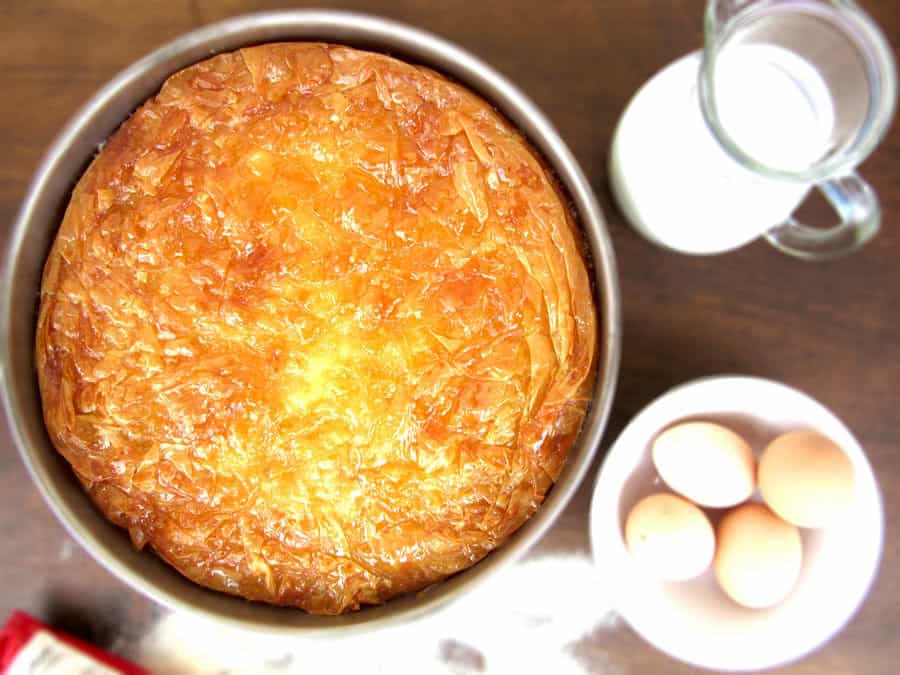
A syrupy custard pie "Galaktoboureko" is a traditional Greek dessert. Made with phyllo pastry, filled with a semolina cream, and soaked in syrup. It's a dessert made to amaze. In Greece, it's as famous as Baklava which I'm sure you are already familiar with.
About Semolina
If you are not familiar with semolina let me tell you what it is. Semolina is the coarse, purified wheat middlings of wheat. It's used mostly in pasta making, but in various desserts also. Especially in Eastern countries. If you are wondering how it tastes, it's almost identical in flavor to wheat baby food. Yeap, it's pretty yummy.
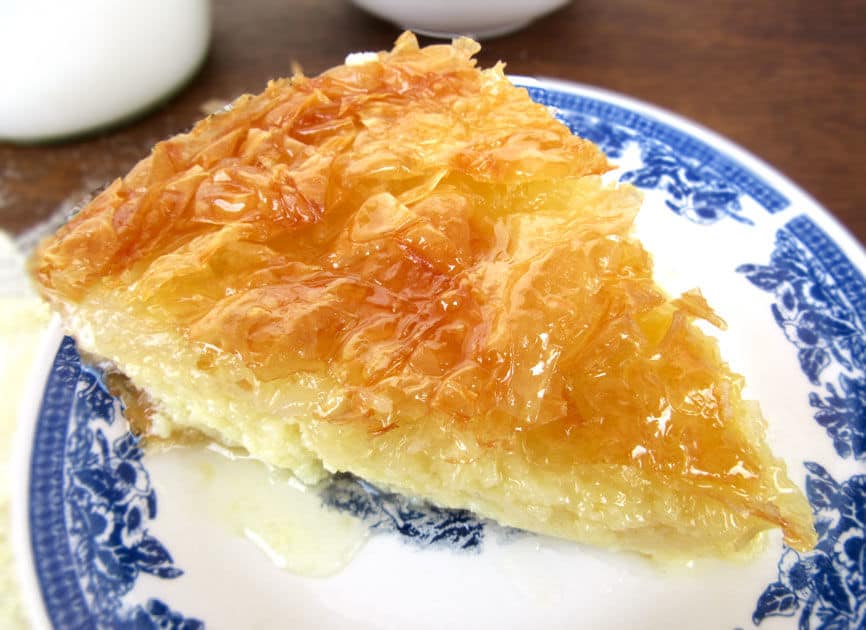
See my other recipes using semolina:
- Greek Baked Apples Stuffed With A Fluffy Custard Cream
- Traditional Greek Honey Cookies (Melomakarona)
- Semolina Pudding
How To Make Galaktoboureko
All you need to pay attention to make the best Galaktoboureko is:
- The syrup has to be nicely thickened and cooled when poured over the hot pie.
- The pie should be baked until the filo is super crispy.
- Grease each filo layer very well with butter so it bakes properly and gets crispy.
- Do not stir syrup while it cooks to avoid the formation of sugar crystals.
So to make Galaktoboureko, first make the syrup inside a saucepan. Do not use a wide one as the sugar will sit on the edges of the pot and won't dissolve. And now you would think, but I can stir that sugar. But that's a no-no when making syrup. The only time you can stir syrup is before it cooks. Once the syrup is starting to simmer you cannot stir it anymore as this may lead to the syrup getting crystallized.
Cook the syrup over medium-low heat for about 6-7 minutes. For the sugar to dissolve properly on its own. Then set the saucepan aside and proceed on making the pie filling.
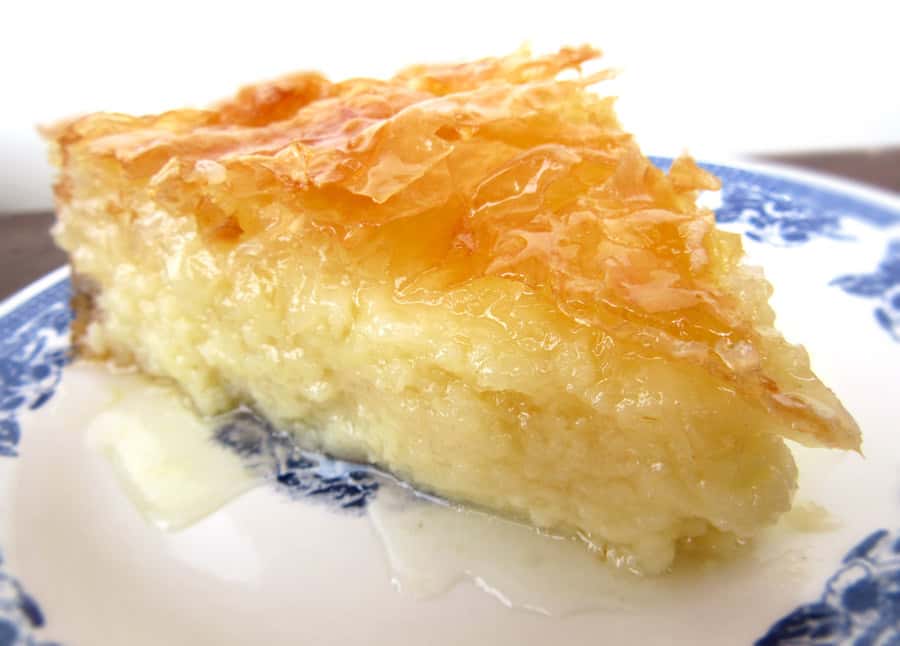
The Galaktoboureko Filling
The filling for Galaktoboureko is made with semolina cream. Semolina cream is much more flavorful and thicker than any other cream. It has a nice fluffy texture while it's still warm and gets firmer when cooled.
Except for the fine semolina, other ingredients to make the cream filling for Galaktoboureko are milk, sugar, eggs, rice flour. And flavorings like vanilla extract (though most people in Greece use old-fashioned Vanilla powder), and lemon zest.
To make the filling for Galaktoboureko you heat the milk with sugar and flavorings. Meanwhile, you beat the eggs in a separate bowl and mix in the rice flour. Once the milk is steamy hot, you slowly pour it into the eggs while whisking the eggs vigorously with a hand whisk.
Once ⅔ of the milk is incorporated into the eggs, you pour everything back to the pot. Add the semolina in slowly and cook for 2 minutes more from the time the cream starts to bubble.
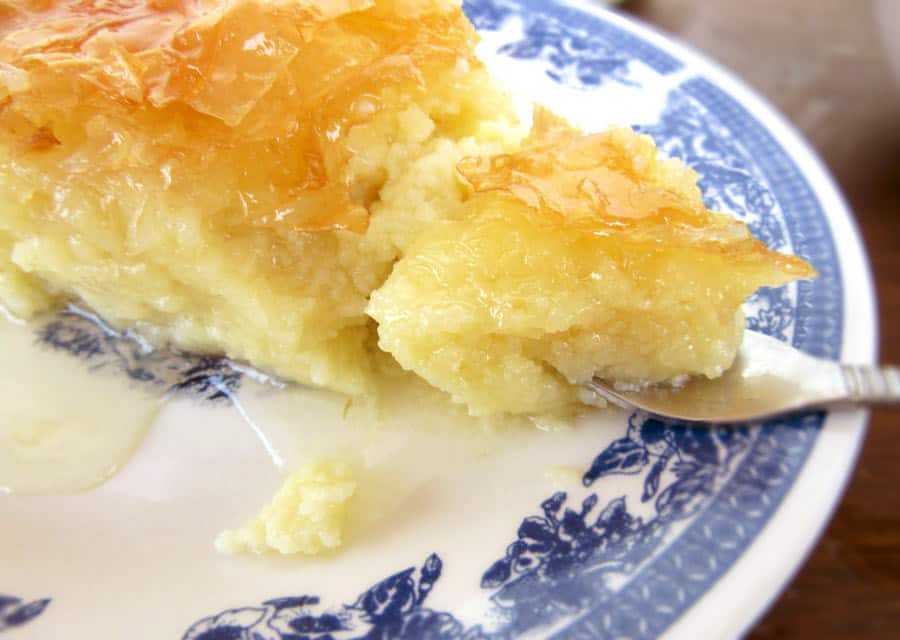
As For The Filo...
Two things to keep in mind when working with filo:
- Add frozen package of filo in the fridge to slowly unfreeze overnight.
- Keep it covered with a tea towel while you work it (e.g. after removing each sheet of filo) so it won't air-dry.
For this sweet pie, you need 7 sheets of filo to make the base and the remaining sheets are used to create the top. To make the base you place each sheet, so half of it covers the bottom of the pan, and half of it hangs out of the pan. The cream is added and then the remaining filo sheets are placed on top. The edges of the sheets that are left to hang out of the pan are overlapped on top to create a real crunchy, crispy pie topping.
I like to give a ruffled look to the filo on the top of the pie as the filo gets crispier this way. See my Bougatsa recipe for example.
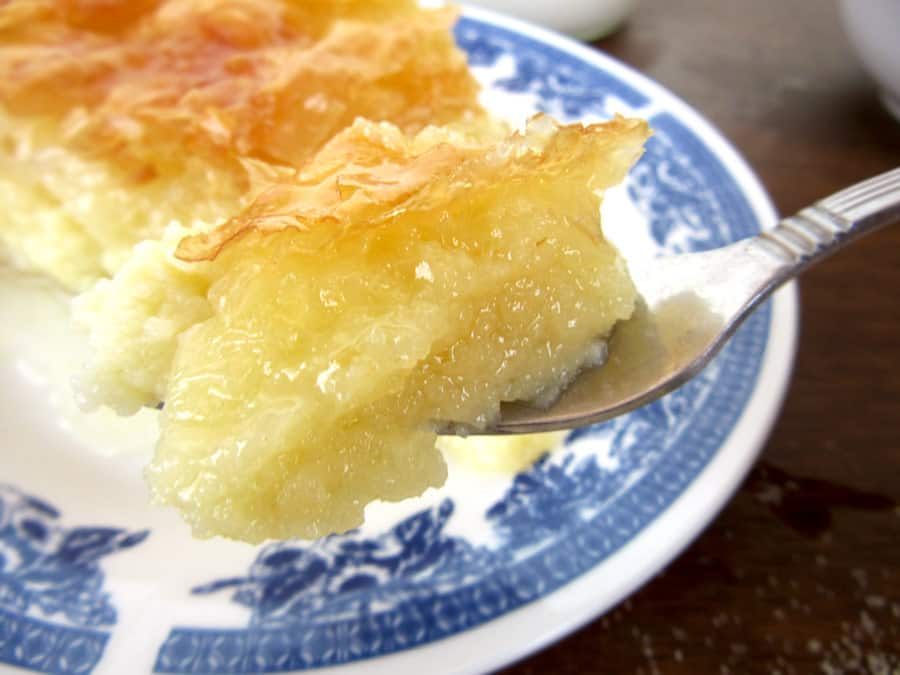
You can place the filo flat on top though if you prefer that look. Also, for this recipe, I use a round 31cm (12-inch) pan. For the same reason, that the filo gets more crunchy, as you get more concentrated filo on top. With this pan, you get 16 hearty pieces.
You can use a square pan instead though. The squared pan option is more helpful if you want to cut the pie into small square pieces. Use a square pan that's about 32 x 25 cm (12.3 x 9.4 inches) You can see how to lay the filo in the squared pan in my Baklava recipe post. Again using 7 sheets at the bottom.
SERVE WARM OR COLD?
That really depends on your liking. Some people like it hot though we mostly eat it cold here in Greece. When it's still warm the filo is very very crunchy and the cream is softer and fluffier like in the pictures. When cold the cream gets firmer but the dessert is not that overwhelmingly sweet as when warm. So try it both ways and tell me your favorite!
Recipe
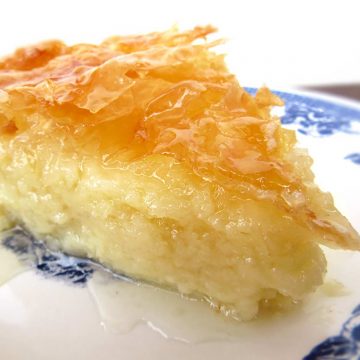
Best Galaktoboureko Recipe Syrupy Custard Pie With Filo
Ingredients
For The Syrup:
- 700 grams sugar
- 500 ml water
- 1 tablespoon lemon juice fresh
- 1 lemon cup
- 1 stick of cinnamon
For The Custard Filling:
- 1250 ml milk
- 200 grams (1 cup) sugar
- 1 teaspoon vanilla extract
- 5 medium-sized eggs
- 65 grams (2.3 ounce) fine semolina for best results, you may want to try one of these Greek labels: Misko, or Melissa
- 65 grams (2.3 ounce) coarse semolina
- 50 grams (3 ⅓ tablespoons) butter
For The Pie:
- 180 grams (6.3 ounce) butter melted
- 1 package (450 grams) filo pastry sheets
Instructions
- Thaw filo in the fridge overnight or for at least 6 hours. Then leave at room temperature within its package for 30 minutes before using.
Make The Syrup:
- The syrup needs to be at room temperature when added to the Galaktoboureko. So you need to make the syrup first and let it cool before making the pie.
- Add all of the ingredients for the syrup to a saucepan.
- Bring to a boil over high heat. Then turn the heat to medium and simmer for about 6-7 minutes or until the syrup thickens. Do not stir the syrup let the sugar dissolve on its own. Turn the heat off and set aside to cool.
Make The Custard Filling:
- Add both types of semolina to a bowl and set aside.
- Add the milk, sugar, and vanilla extract to a cooking pot and heat over medium-high heat.
- In a mixing bowl beat the eggs with a whisk. Once the milk mixture gets steamy hot gradually ladle half of it into the eggs while whisking the eggs constantly. Transfer the mixture back to the pot.
- Drop the heat to medium. Give it a minute to reach a steamy hot temperature again and gradually mix in the semolina.
- Continue stirring with the whisk until cream starts to bubble.
- Remove from heat and let stand for 10 minutes. Then stir in the butter.
For The Pie:
- Preheat oven to 170°C/ 340°F.
- Lay open the stack of phyllo on your working surface. And cover it with a tea towel so it won't air-dry.
- Grease a 12-inch (30 cm) round baking pan with some of the melted butter.
- Take 4 filo sheets (one at a time) and place them in the pan creating a cross shape (half of the sheets will be hanging out of the pan) grease the surface of every 2 filo with melted butter.
- Add 2 more filo sheets folded in order to fit in the pan (fold a bit on the sides to fit) greasing between each filo with butter.
- Add the cream and spread it evenly with a spoon.
- Add 2 filo sheets folded on top of the cream (again brush each filo with some butter).
- Overlap the filo that hangs out of the pan (it's okay if it's uneven and ruffled). Don't forget to brush with butter!
- Add the remaining filo sheets ruffled on top to create a crunchy topping.
- Gently score the top with a knife and divide the Galaktoboureko into pieces.
- Bake for about 50 minutes until deep golden lightly brown on top and crunchy.
- Slowly ladle the cold syrup over the Galaktoboureko right as you get it out of the oven.
- Allow to cool inside the oven with the oven door open.
- When it gets to room temperature you can cut and serve or refrigerate for 4-6 hours and enjoy it cold!
Nutrition
YOU MAY ALSO LIKE...

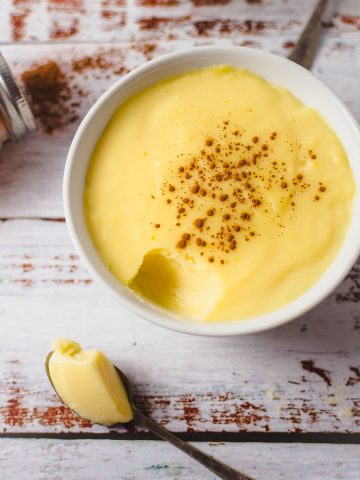
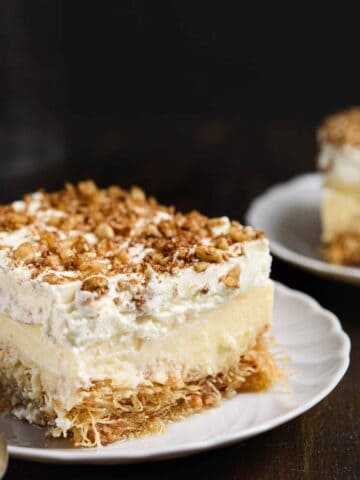
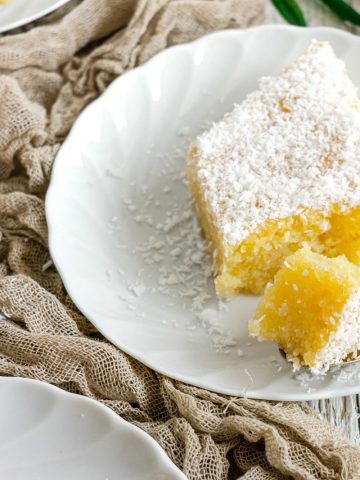
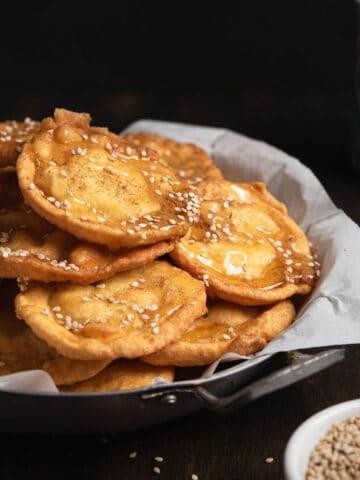
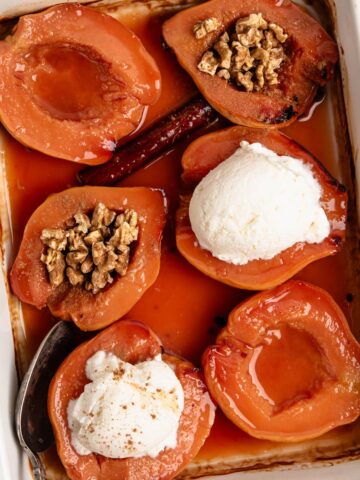
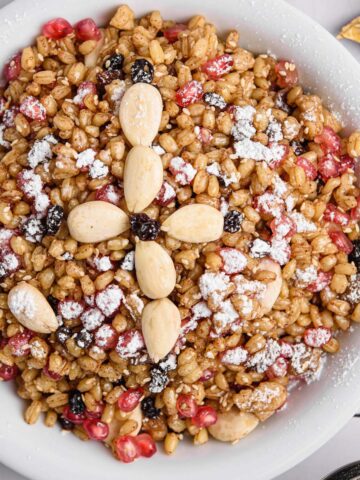
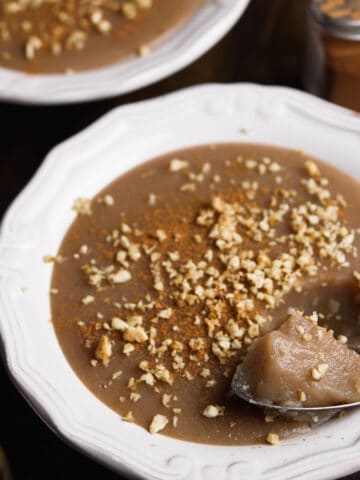
Leave a Reply